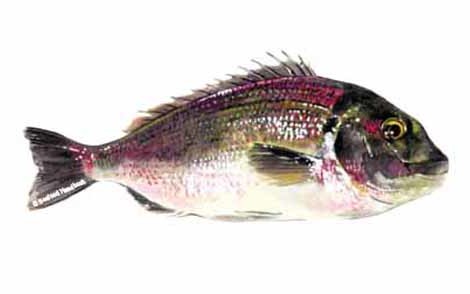Seafood Handbook Finfish Page
The Seafood Handbook is the most comprehensive seafood directory available online. Featuring more than 100 of the most common seafood species in the U.S. market, the Seafood Handbook is the ultimate guide to seafood sourcing and preparation, brought to you by the editors of SeaFood Business magazine. And it’s free!
For each type of seafood species, there is a comprehensive overview of the item, its origin, history, availability, product attributes, nutritional value and cooking tips, along with an original hand-drawn depiction.
Explore Finfish by searching here:
Though regarded as a substitute for cod, many chefs, including James Beard, have argued that “cusk ought to be more popular in its own right.” A member of the Gadidae family, along with cod, haddock and pollock, cusk resembles its relatives through the head, but the rest of its body looks as if… Read More
A giant blue marlin was the Cuban fisherman’s quarry in Ernest Hemingway’s classic novella The Old Man and the Sea. The carcass of Santiago’s marlin measured 18 feet in length. While blue marlins are the largest of the marlin species and prized by anglers for their fighting nature, the… Read More
The humble herring once determined the fate of kings and empires. The powerful Hanseatic League of Germany and Scandinavia collapsed in the 15th century when herring stopped spawning in the Baltic Sea. Treaties worth millions of dollars were negotiated for herring rights in the New World. But, in… Read More
Trout represents the oldest aquaculture industry in North America, dating back to the first trout hatchery in the 1880s. Today, Idaho accounts for 70 percent of the rainbow trout raised in the United States. All rainbow trout sold domestically are farmed, either in concrete raceways or earthen… Read More
Mackerel is a handsome but underrated fish, probably because it doesn’t have the mild-whitefish profile American consumers are most comfortable with. The mackerel looks a lot like its cousin, the tuna, but smaller — usually 1 1/2 to 2 1/2 pounds. Shaped for swift swimming, the Atlantic mackerel… Read More
Albacore is best known as America’s highest-grade, “white meat” canned tuna. In fact, it’s the only tuna meat allowed to be labeled “white meat.” However, it has also developed a reputation out of the can in fresh and frozen markets. The albacore has a streamlined, torpedo-shaped body.… Read More
If ever there were a fish with an identity crisis, it’s the lingcod, for despite its name, this species is neither a cod nor a ling. Rather, it’s a Pacific greenling, from the family Hexagrammidae. The lingcod likely got the name ling from early settlers who related it to European lings but… Read More
The name “porgy” comes from an American Indian name meaning “fertilizer,” a common use for these abundant fish during Colonial times. While porgy is the preferred name for the species in the United States, where it is sold mainly in ethnic markets, in Europe it is called sea bream. About 15… Read More
Tracing its origin to the Nile River, tilapia has been farm raised for decades and is cultivated in warm waters the world over. It is the second-most cultured group of fish in the world, exceeded only by carp. Domestically, tilapia are cultured in the southern and western states. Costa Rica and… Read More
Arctic char is a member of the trout and salmon family, and it physically resembles the salmon. Its silvery skin is dappled with pink along the lateral line, and the fish sports green and blue coloration on its back and upper sides. Arctic char is also anadromous like salmon, migrating from… Read More

















